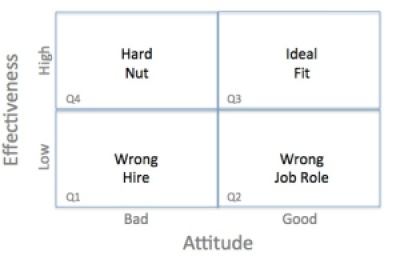“He’s my best sales guy. He makes his numbers quarter after quarter! But everyone dreads it when he comes into the office.” My friend was on the verge of tears – it was clear that he was going to have to do something about his sales guy, if he didn’t want others to quit. But he was worried about his star salesman would react and he was not looking forward to it.
We’ve all faced this issue of what to do with that employee – the trustworthy finance guy, who upsets your team members often over trivial amounts; the brilliant technologist who cheeses everybody off with his superior attitude, or the HR manager, who despite the many years she’s been with you, who’s not pulling her weight any more. The timing is rarely right to confront them and the longer you put it off the worse it’s likely to get. We also worry about how we got here and how best to handle it so we retain them without too high an emotional cost. If you are like me, then you put it off for a better time, which rarely comes.
Hiring people is always one of the top 3 problems I hear managers or founders talk about. Implicit in this of course is that matter of hiring the right people. Yet, even after we’ve hired the right people, as neither organizations nor the people stay constant, we run into all kinds of issues. Gil Amelio, who was an inspiring leader (and CEO) at my first employer National Semiconductor, taught me a very simple framework to both talk about this and to aid action.
Attitude and Effectiveness Successful organisations look at not just at proven capabilities and experience that would make a prospective employee effective, but also their attitude and fit with your organisational culture. He used the familiar four quadrant framework, with effectiveness along the y-axis and attitude (or cultural fit) along the x-axis as shown in the figure below.
Quadrant 1 – Neither the right attitude nor effective These are the easiest folks to deal with – they are basically hiring mistakes you’ve made. Ideally you’d not have anyone in this quadrant or if you do, you’d fix your hiring process to minimize recurrence. Lou Adler, author and CEO of the Adler group in his recent article titled “There Are Only Four Types of People — Are You Hiring The Right Ones?” terms these folks Type 1: Those you should never hire!
Quadrant 2 – Have the right attitude but are not effective Usually this is a sign that these folks are in the wrong job. They may have been effective, even in the same job, but no longer are, because the jobs requirements have evolved or they haven’t. Or you’ve placed them in the wrong role. The ineffective sales guy may bloom in a business development role or inside sales job. The trick is to find them a role that they can be effective in. If your organisation is big enough, you may have one or more such roles – sometimes the right role may not be within your department or even company, in which case its best to help them find the right role, whether inside or outside your company.
Quadrant 3 – Have the right attitude and are effective These are your stars – the people who perform consistently and lead from the front. The trick with these folks is to ensure that they are constantly learning and growing. Folks in Quandrant 3 can fall into Quandrant 2, when your company and your needs grow fast and they don’t grow as fast. These are the folks you want to be hiring and your company and its processes should be geared to finding, attracting, retaining and growing Quadrant 3 folks.
Quadrant 4 – Don’t have the right attitude but are effective This is the hardest group to deal with. The obnoxious sales person my friend had to deal with, the supercilious technologist or rude finance guy we met all fall into this quadrant. Two things make it difficult to effect change with these folks –
- they are deemed successful and have been rewarded in the past, despite their interpersonal shortcomings.
- They are often positions deemed critical, that make change not just unpalatable but downright scary. “What’ll happen to my sales, if this guy leaves?” or “Will I find another trusthworthy finance guy?”
Organizations suffer the most, because most of us don’t know how best to handle Quadrant 4 folks. The first step is to recognize not only the existence of these four quadrants but that people can move within the quadrants. This is most commonly seen from Quadrant 2 to Quadrant 3 (more effective) through skilling and occasionally to Quadrant 2 from Quadrant 3 (less effective) when the job needs grow and person doesn’t.
I’ve found talking about the four quadrants and even mutually agreeing with your team members where they see themselves and where their peers or you see them helps immensely. This way when it is time to have the hard conversation, you both have a framework and vocabulary that can help keep the conversation professional. In my experience, almost always folks in the Quadrant 4 will have to be let go. We’ve had the occasional technical person build out their interpersonal skills and make the move from Quadrant 4 to Quadrant 3.
Let me know how this works for you.





You must be logged in to post a comment.